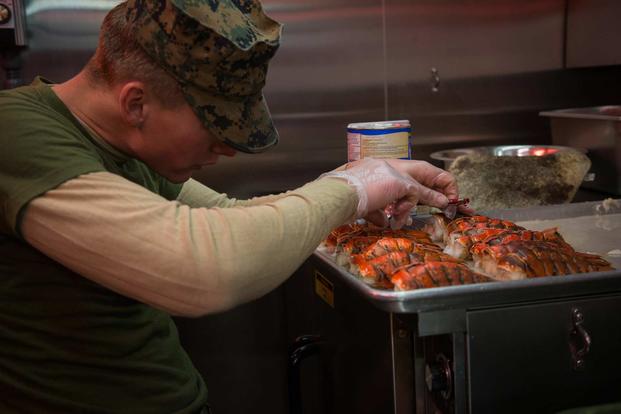In the wake of a startling report from the organization Open the Books showing massive federal government expenditures in the final month of the fiscal year, troops everywhere want you to know that they deserve steak and lobster every once in a while. But the Defense Department spending problems highlighted in the report may have little to do with surf and turf dinners.
The 32-page Open the Books report, published this month, showed the federal government as a whole spent an astounding $97 billion in September 2018 as the fiscal year was drawing to a close -- up 16 percent from the previous fiscal year and 39 percent from fiscal 2015. DoD spending accounted for $61.2 billion of that spending spree, awarding "use-it-or-lose-it" contracts and buying, among other things, $4.6 million worth of crab and lobster and a Wexford leather club chair costing more than $9,300.
"This kind of waste has to stop. It's an insult to taxpayers," Sen. Rand Paul, R-Kentucky, tweeted, sharing a Fox Business story about the seafood buy.
This kind of waste has to stop. It's an insult to taxpayers. https://t.co/o0Z9uAzaqp
— Senator Rand Paul (@RandPaul) March 12, 2019
Military veterans were quick to protest, however, saying the nice food is often used by military units to boost morale on grueling deployments or to soften the blow when bad news comes.
"Surf & turf night was a regular thing even when I was in Iraq," tweeted Maximilian Uriarte, a former Marine Corps infantryman and creator of the popular comic strip Terminal Lance. "Feeding troops lobster a few times a year is not a waste of money."
They did, surf & turf night was a regular thing even when I was in Iraq. Feeding troops lobster a few times a year is not a waste of money. https://t.co/m8eud7AO2U
— Maximilian Uriarte (@TLCplMax) March 13, 2019
Fred Wellman, a retired Army officer and the CEO of veteran-focused PR firm ScoutComms, also chimed in.
"Nothing that ever beat the morale boost like steak and lobster night downrange. Period," he tweeted. "Taking care of the troops that you and your peers sent to war isn't 'waste.' Gutlessly letting the war go without supervision of the actual effort is! But no...let's take their good food."
Nothing that ever beat the morale boost like steak and lobster night downrange. Period. Taking care of the troops that you and your peers sent to war isn't "waste". Gutlessly letting the war go without supervision of the actual effort is! But no...let's take their good food. https://t.co/In6qDa9xFn
— Fred Wellman (@FPWellman) March 13, 2019
Focusing on the lobster, though, misses the point on how the Pentagon's spending habits actually do troops a disservice, according to Mandy Smithberger, director of the Center for Defense Information at the Project on Government Oversight.
"The lobster tail example captures one's imagination, but that's not where congressional oversight needs to focus," Smithberger told Military.com. "As you see spending go up, you see the amount of this use-it-or-lose-it spending going up as well, and that's really not to the good."
She said the billions of expenditures demonstrated DoD efforts to "use money to paper over management problems."
"None of our weapons systems are affordable and arriving on time; we can't take care of military housing," Smithberger said. "[There are] recruitment and retention problems; [the military] prioritizes procurement over training. As long as you keep having money thrown at these problems, people aren't making tough decisions."
For the Pentagon, the biggest year-end expenditure was professional services and support, accounting for $9.6 billion of spending in September 2018. Then came fixed-wing aircraft, a buy of $8.6 billion. Other top spending items include IT and telecom hardware services and support, $4.7 billion; combat ships and landing vessels, $3.9 billion; and guided missiles, nearly $2 billion.
More than the individual items and services purchased, the biggest problem may be the way the spending happens -- and the perverse incentives not to end up with leftover money at the end of the year, because it might negatively impact efforts to obtain funds the following year.
"Congress is a lot of the problem," Smithberger said. "Appropriators look and see whatever is not spent, they take and use for their pet project."
As the Pentagon budget request continues to balloon year after year, Smithberger said she'd like to see incentives to save money and a system that would keep planners from worrying about a loss of resources the following year.
"If the department showed that it was able to save tens of billions of dollars, they would have a more credible case for the topline," she said.
There's plenty of evidence, Smithberger said, that money alone doesn't solve or prevent institutional problems. For example, she said, the Navy was making big investments in shipbuilding when two guided-missile destroyers collided with commercial ships in separate deadly incidents within months of each other in 2017. While investigations did cite scarcity of resources, training was found to be a major shortfall contributing to the disasters.
When it comes to defense spending, "it's a lot of hollow rhetoric and it's really costly when we decide to only express our support through appropriations and not through real decision-making and responsibility," she said.
-- Hope Hodge Seck can be reached at hope.seck@military.com. Follow her on Twitter at @HopeSeck.















